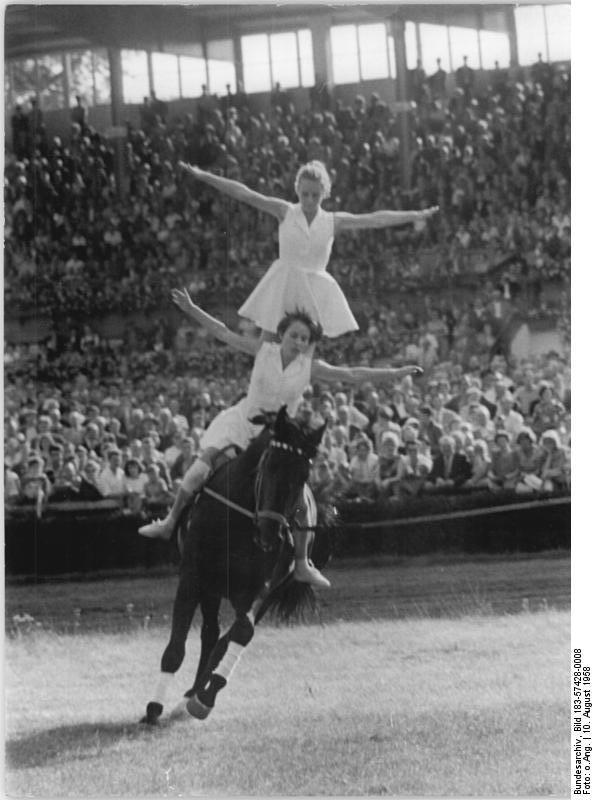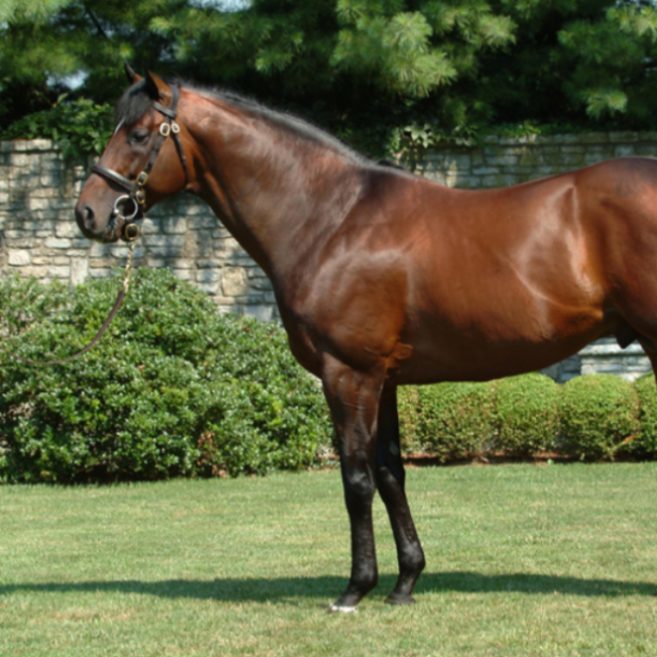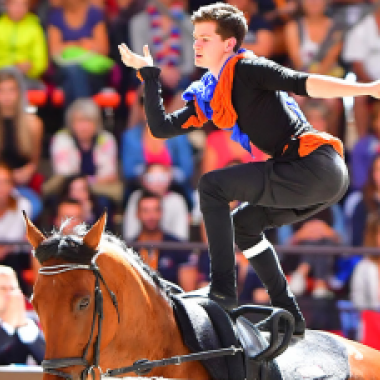Competitive Vaulting:
In competitive vaulting, vaulters compete as individuals, pairs (pas-de-deux) and teams. Beginning vaulters compete in walk or trot while experienced vaulters compete in canter. The vaulting horse moves in a minimum 15-metre diameter circle and is directed by a lunger (or “longeur”) who stands in the center. In competitive vaulting, the rider and horse will both be judged on a scale from 1 to 10.
Vaulting competitions consist of compulsory exercises and choreographed freestyle exercises done to music. There are seven compulsory exercises: mount, basic seat, flag, mill, scissors, stand and flank. Each exercise is scored on a scale from 0 to 10. Horses also receive a score and are judged on the quality of their movement as well as their behavior.
Vaulters compete in team, pas-de-deux and individual categories. An individual freestyle (also known as Kür) is a 1-minute program, the pas-de-deux kür is 2 minutes while the team is 4 minutes. They are all choreographed to music. The components of a freestyle vaulting routine may include mounts and dismounts, handstands, kneeling and standing and aerial moves such jumps, leaps and tumbling skills. However, many of these skills are only seen in the highest levels. A typical routine for a child or beginner will more likely contain variations on simple kneels and planks. Teams also carry, lift, or even toss another vaulter in the air. Judging is based on technique, performance, form, difficulty, balance, security, and consideration of the horse; the horse is also scored, taking up 25% of the total score.
Vaulting horses are not saddled but wear a surcingle (or a roller) and a thick back pad. The surcingle has special handles which aid the vaulter in performing certain moves as well as leather loops called “cossack stirrups”. The horse wears a bridle and side reins. The lunge line is usually attached to the inside bit ring.
Vaulting horses typically move on the left rein (counterclockwise), but in some competitions the horse canters in the other direction. Two-phase classes of competition also work the horse to the right. While many European clubs do not compete to the right, they still work at home evenly both directions, believing this benefits the horse and the vaulter.
The premier vaulting competitions are the biannual World and Continental Championships and the World Equestrian Games (WEG) held every four years. In many countries, vaulting associations organize and sponsor national, regional and local events every year. In 2011 there were at least 24 countries with such organisations.
Competitive Movements:
Vaulters perform movements on the back of the horse. Novice and beginning vaulters may perform at the walk or the trot while higher level vaulters perform at the canter. There are compulsory exercises and depending on class the vaulter performs seven or eight of them.
Compulsory Flag
| Movement |
Description |
| Vault On |
The vault-on leads to the frontways seat on the horse. After jumping on both feet, the right leg swings up immediately, as high as possible, lifting the pelvis higher than the head, while the left leg remains stretched down. The shoulders and hips are parallel to the shoulder axis of the horse. When the pelvis is at the highest possible point, the vaulter lowers the stretched right leg and lands softly, erect and centred in the seat astride with the upper body vertical. |
| Basic Seat |
An astride position (the vaulter sits on the horse as a rider would), with the arms held to the side and the hands raised to ear level. Hands should be held with closed fingers and palms facing downward, with the fingers arching slightly upward. Legs are wrapped around the horse’s barrel, soles facing rearward, with toes down and feet arched. Vaulter holds this position for four full strides. |
| Flag |
From the astride position, the vaulter hops to his or her knees and extends the right leg straight out behind, holding it slightly above his or her head so the leg is parallel to the horse’s spine. The other leg should have pressure distributed through the shin and foot, most weight should be on the back of the ankle, to avoid digging the knee into the horse’s back. The left arm is then stretched straight forward, at a height nearly that of the right leg. The hand should be held as it is in basic seat (palm down, fingers together). The right foot should be arched and the sole should face skyward. This movement should be held for four full strides after the arm and leg are raised. |
| Mill |
From the astride position, the vaulter brings the right leg over the horse’s neck. The grips must be ungrasped and retaken as the leg is brought over. The left leg is then brought in a full arc over the croup, again with a change of grips, before the right leg follows it, and the left leg moves over the neck to complete the full turn of the vaulter. The vaulter performs each leg movement in four strides each, completing the Mill movement in sixteen full strides. During the leg passes, the legs should be held perfectly straight, with the toes pointed. When the legs are on the same side of the horse, they should be pressed together. |
| Scissors 1st part |
From the astride position, the vaulter swings into a handstand. At the apex, the vaulter’s body should be turned to the lunger and the inner leg should be crossed over the outer leg. The vaulter than comes down and lands so that she is facing backward on the horse, toward the tail. |
| Scissors 2nd part |
From seat rearways on the horse the vaulter swings up with the outside leg over the inside leg, and lands facing forward once again. If the vaulter lands hard on the horse’s back, they are severely penalized. Scissors is judged on the elevation of the movement. |
| Stand |
The vaulter moves from the astride position onto the shins and immediately onto both feet, and releases the grips. The vaulter then straightens up with both knees bent, the buttocks tucked forward, and the hands held as they are in basic seat. The vaulter must hold the position for four full strides. [1] |
| Flank 1st part |
From the astride position, the legs are swung forward to create momentum, before swinging backward, and rolling onto the stomach with a straight body, with a full extension of the legs so that the vaulter nearly reaches a handstand. At the apex, the vaulter jackknifes her body and turns the body to the inside, before sliding down into a side seat. The vaulter is judged on form, landing, and elevation. |
| Swing off |
From seat astride, the vaulter swings to handstand position with closed legs, arms extended to attain maximum elevation. At maximum arm extension, the vaulter pushes against the grips, and as a result of shoulder repulsion, attains additional elevation and maximum flight, landing to the inside of the horse, facing forward, on both feet. |




